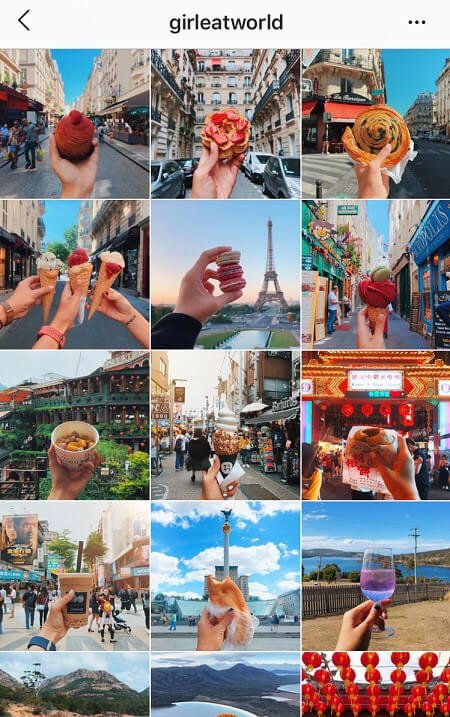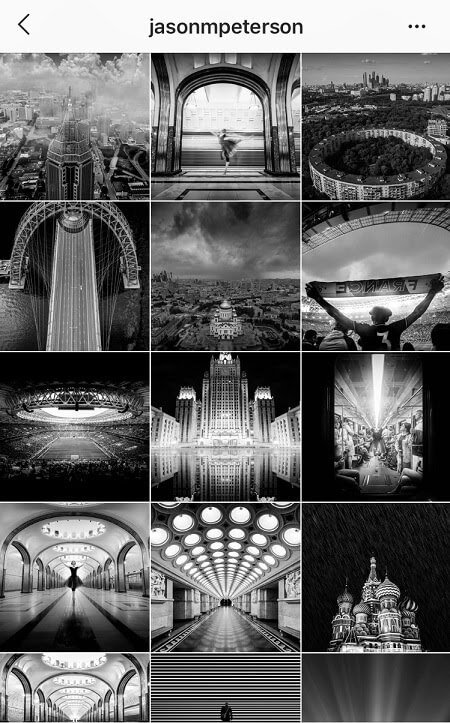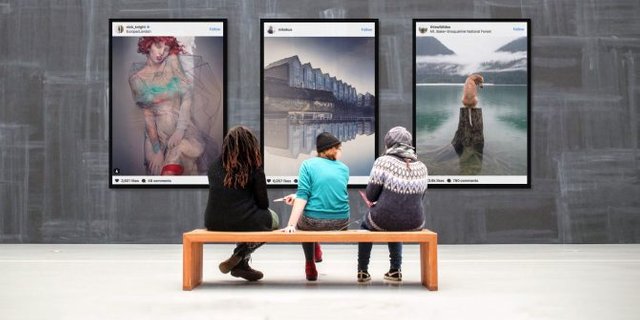Instagrama classics, that is, if nobody comes to the Insta to view food photos.
Today's text will be unusual. It is not a classic note. The theses that I present today result from my long reflection on certain phenomena. At the same time, they are like scientific essays from the XIXth century, a more certain premonition than a well-established argument in scientific research. A suggestion or maybe an introduction to the discussion rather than a hard thesis about which I have absolute certainty. Here, then, I want to offer you a new look at Instagram.
If we wander long enough on the Internet, sooner or later we come across the sentence that "Real life does not look like Instagram pictures". Sometimes these are texts with a social basis, sometimes more psychological, sometimes purely technical. Their goal is to reveal the "lie" of Instagram, which screens reality, ultimately confronting the viewer with content sifted, stylized, and torn from everyday reality. Discovering the truth about Instagram is in a way a therapeutic confirmation that life does not look like on the pictures. Unveiling the truth that the creators of the images cover in front of the recipient.
Only that in this way of thinking about Instagram as a social service. One in which the creators, when taking photos, document their lives, clothes, trips, food, cats, curiosities they came across during the day. My suggestion is as follows. Let's not treat Instagram as a social networking site. Actually - narrowing down, do not take photos on Instagram in this way, because the relationship should be treated a little differently. I leave these behind my current reflections.

https://www.instagram.com/humphreyandgrace/?hl=en
If Instragram was not supposed to be a social network, then what would it be? The answer is - the space of realizing a certain aesthetics. Instagram would be not so much a portal in which people show their lives, what they eat, they do, how they dress, only the portal in which they show how they understand and implement aesthetics which could be called "instagram" for lack of a better word. The social dimension of Instagram would be something secondary to what we could call a platform for realizing aesthetics. Where is this reflection from? Above all, undoubtedly the aesthetic issues are key on Instagram, and what's more - they are more important than the subject matter of the photo - as anyone who has read the complaints about triviality of topics raised by Instagram creators knows.
However, this is not the only point - you really have three key elements here. The first is the awareness of the existence of a certain aesthetics and the manner of its implementation. And indeed - more or less familiar with Instagram, Internet users are aware of what is Instagram - whether it is about places, topics or, what is more important - elements of reality. It is quite natural for us to separate what is surrounding us in the aesthetics of the Instagram - the statement that something is "Instagram" entered the language and does not necessarily mean that something is fashionable, more so - that it will look good in the pictures. People who take photos on Instagram or even those who often watch them have no problem with dividing what is Instagram and what is not. Sometimes, of course, some things are included in this category only temporarily, but some are well. Like, for example, unpainted wooden surfaces or things gently aged or retro.
Another thing is the fact that people creating photos on Instagram are perfectly aware of what they are doing. Of course, there are a lot of accounts that do not work in accordance with Instagram's aesthetics (about them in a moment), but most creators know what they do - how to choose elements for the picture, how to put them in the frame, how to enter the aesthetics. Most of them do not create anything new, they recreate a variation on a topic that the canon has already been set. We do not necessarily create something from scratch, rather we assume the assumptions of how such a picture should look like. On the other hand, there is a recipient. We like to imagine it as an unconscious (hence the need to show him that the world does not look as it seems to Instagram), but the truth is that he is aware of the existence of this aesthetics. What's more, it rewards not only individual photos taken in this way but also - the internal aesthetic coherence of the creator - in other words, the fact that the person uploading pictures not only understands the subject but implements it in a certain individual and consistent manner. In this respect, you can see that users - in a more or less conscious way, also put on the aesthetic dimension. In this respect, the creator who implements his topic in the top-down categories is effective.

https://www.instagram.com/fursty/?hl=pl
The existence of the awareness of such dominant and schematic aesthetics can also be demonstrated by the fact that many people reject it. On Instagram you can find accounts deliberately not fitting into the accepted aesthetics, ugly, not because the person uploading photos did not have the right options in the form of a good phone or the ability to compose a nice photo. It is about the whole trend of throwing ”ugly" photos (in the context of the Instagram aesthetics), rejecting certain rules that govern the Instagram canon. It is hard to find something more confirming the existence of any aesthetic canon than the appearance of people who consciously reject it or create something against it. At the same time - Instagram is a place where people are imbued with imitators - people who want to take pictures exactly as others did. It is also an element that assures us that at least some of the instagram creators are well aware of which schemes should be repeated - which again confirms their awareness of their existence.
What seems to be particularly interesting to me is the fact that when we look at the most typical and popular themes of photos on Instagram, we will see a similarity to classical art, or rather to its most classic themes. So we have a selfie that is the equivalent of a self-portrait (including an element that is sometimes forgotten - that the self-portrait does not reflect the real image of the painter but some vision of it - the selfie does the same). We have a dead nature - for example, photos of food (food was a natural and fairly common element of still lifes). Flatley or pictures taken from above the objects arranged in a predetermined composition (they must match each other, form a common whole, fit within the framework adopted by the creator) - to tell you the truth, that even there are courses of taking such photos it is hard to do more conventionalized - like dead nature. Another thing is the beautiful pictures from the trip - best showing the places either known or idyllic, or considered charming - what beautiful gives us the need that stood behind classic landscapes. Pictures of homesteads or their owners in the background of the possessed objects resemble those portraits ordered by usually wealthy burghers inside, whose task was similar - boasting of wealth and commemorate the possessed goods and their social position. Even the Institution's nakedness is nothing new - if you go to any art gallery, you'll find a whole lot of nudity. And so clear - the creators did not usually paint themselves, which does not change the fact that the naked body - especially idealized - young, muscular, with smooth skin - has always been an important topic of classical art.

https://www.instagram.com/girleatworld/?hl=pl
You can get here with some holy indignation - that I'm trying to convince you that Instagram is actually classical art. This is not my intention. It's more about something else. Well, after we have departed from the classical themes in art - actually from the end of academic in art, the creators - in this case, painters (though not only), slowly departing from the classic showing of classical themes - in favor of new, more individual, less enjoyable for viewer of content. As a result of these changes (and also a million other factors influenced artists in the last two hundred years) contemporary art created after World War II is already quite different today for the average recipient. Following the line of maximum simplification (maximum!) - it went in the direction of not only new topics but also new forms of expression. It has ceased to be so figurative, it does not take up these nice topics, it is much more an emanation of not so much accepted canons as the individual actions of the creator. In art you can do a lot more than you could have at one time, and at the same time - a bit like in the case of music - it isolates itself from an ordinary viewer. In other words - just as people used to go to the art gallery to look at a new nice picture, today they can go for emotions, reflection or something unknown, but not necessarily - in a simple, classic way of being nice.
Art has changed but have people changed? Well, the thesis that human taste and sense of aesthetics change much slower than trends in contemporary art, is not particularly revealing. It is not about these anecdotal "deer in rutting" but rather about the fact that people have a tendency to evaluate highly symmetrical, classically "nice" and colorful things - which for many art experts balance on the border between kitsch. If you look at the paintings sold on the streets (and let's not hide, those definitely better reflect the taste of people than those that can be bought in Galleries for heavy money) then we will see that, apart from reproductions of classical masters, a whole lot of pictures that just implement the most typical subjects - here is picture of a horse, there is a picture of flowers on the table, somewhere else a landscape (necessarily with sunset) or some other idyll. These are not usually particularly beautiful works, but what's interesting - almost everywhere in the world (where I've seen them) show the same cross-section of classic themes. None of the street painters (again, those I saw) did not imitate Kandisky or Pollock, but quite often they tried to pretend to be dorms. Because people like it, they want to hang themselves in the bedroom.

https://www.instagram.com/jasonmpeterson/?hl=pl
What does this have to do with Instagram? Well, actually on Instagram, users separate from the chaff. Nobody asked them to appreciate symmetrical images, inscribed in the golden division or giving classic art categories more than others. And yet people do it, and what they do more consistently. And not necessarily all popular accounts are absolutely identical, although as I mentioned - not only the fulfillment of the canon is appreciated, but also some internal consistency of the Instagram creator. It is interesting that this passion for classic categories comes from below. As if every ”like” left under a photo that fits into this unrecorded canon, confirms its existence - and confirms the willingness of the audience to see even more of the same photos. A question that is certainly somewhat bothering - whether our weakness for such categories is the result of a certain education and growth in a world dominated by classical art patterns, or - has nothing to do with it and results rather from certain - not necessarily dependent on history art, weakness of a man who, for example, looks for symmetry everywhere and feels good with it.
Here, of course, the question remains - can Instagram creators could be considered as an artist? This is a complicated question. On the one hand - one would like to choose a simple answer and say - not to change the artist's words to the slightest. On the other - we'll take a look at what they do. What would appeal against being called artists would be that they do not necessarily have to be very creative - because they move in the mentioned canon. But on the other hand - it's a bit like what academics did. They knew what and how to paint and tried to do it as best as possible within a clearly defined framework. At the same time - undoubtedly putting a photo on Instagram is definitely a more thoughtful action than simply taking photos of the phone. The first thing is the selection of photos that will appear on the profile. Here is the decision which will fit into the aesthetics and what does not. Actually, this is a secondary decision after that regarding what part of life will be photographed. The second thing is to adapt the picture to show in the fairly limited Instagram framework. This is not a place where you can do anything - because, however, we have a "frame" of the photo that limits us. Something like a canvas. In addition, imposing a filter, retouching - this is an element of the necessary transformation, or if you prefer to correct reality - so as to best fit in with the accepted elements of the canon.
It is also worth noting that although the photos on Instagram do not shift any limits of aesthetics - sometimes quite trivial, in most of them - especially those made consciously, you can see the desire to catch some beauty. Of course, this is beauty understood in a very conventional way - but there is a desire in people to sift out of the world elements that they consider ugly. If we think of Instagram as a social space - it may seem dangerous to us. Although on the other hand - if we look at our family albums, we usually do not have any pictures discovering the ugliness of the world, on the contrary - they always show this idealized vision of the past consisting of holidays, birthday parties and communions. No less - we will take this different frame of interpretation - then Instagram is not so much hiding the ugliness of the world, but rather - it is a place where people come to satisfy themselves with aesthetics. This is not bad or new in itself. Truth be told - taking into account how it was painted in a classic way - it fulfills exactly the same role as the rather conventional (and not always outstanding paintings) that could be seen in galleries. Clear religious themes often suggested a vision of suffering, but if you go to an art gallery in Italy, you will see more or less the same lactating mothers as Instagram. The difference is that in the Italian gallery it is a non-stop the same mother. Returning to the point - I do not think that human escape from the ambiguity of life in a relaxed, conventional aesthetics was something new. Sure - popular culture imposes on us a colorful vision of the world, although I have the impression that the insensitivity of people to the problems and ugliness of the world is often overestimated. I have the impression that escapism would not be so popular if everyone felt well and had no problems. But this is a subject for other considerations. It is also worth adding that perhaps what distinguishes art from the viewer most today is the fact that it does not provide an escape. This is not a disadvantage - we can say that even the advantage (especially if we are convinced that confronting the world's problems is our intellectual duty) but it is impossible to hide - the beauty of the world attracts people more than suffering. And there is nothing very strange about it.
For this, it is worth considering the element related to the money. Well, as you know the most popular creators on Instagram - they earn quite a lot of money. Of course, the mechanisms that accompany this earning a bit different than in the world of art, but at the same time - history knows a whole bunch of artists - including outstanding artists, creating mass and custom, using their popularity to create a whole machine producing paintings for the order. To the extent that at some point we are not sure whether they were painting themselves or if it was done by one of the students employed to speed up production. The vision of the creator doing something for himself, without having to acquire a patron, patron or market recognition - it's a fairly new concept. Earlier, art and money were closely related and there was definitely a lot of business in it. And although there may not have been a typical product placement, all the paintings where the patron was sure that he will be shown in a good light and in a way that will make others admire him - has something of content. Of course, it would be coarse to equate one element with the other but - rather, the fact that the Instagram is money does not necessarily contradict ours - developed here for some time comparisons with the world of art.
As I wrote at the beginning - this is just a suggestion to change the optics. Why would it serve? First of all, getting rid of this argument about falsifying the vision of the world. Truth be told - every collection of photos falsifies the image of the world. No less - perhaps the best way to cure Instagram's "lies" is to change the framework for the interpretation of the pictures posted there. The second issue is rather a matter of a slightly different reflection on the phenomena in the world of new media. We talk a lot about the relationship between new media and social platforms and society. At the same time - I have the impression that we lack such an attempt to look at things a bit differently. Perhaps more from the perspective of continuation than news. In the meantime, I have the impression that people paradoxically often strive for previously known forms, and those that are just emerging often quite quickly conventionaliz. So my proposal is also an attempt - at least outside the world of the university (academics think about everything as a man thinks about it longer but not necessarily whoever reads them) to reflect in a different way on what surrounds us.
At the very end - it is simply interesting, when instead of recognizing that reality can be interpreted in only one way, we will try - at least for pure intellectual entertainment - to take a different perspective or propose something. Of course, if we were to take it seriously - it would probably need detailed research, examples or dealing with what we do not encounter in theory. But the whole plus of not taking things seriously is the possibility of considering things without having to do a lot of work. Paradoxically - in this way a lot of sensible theories appeared in the world - including theories which, if only because then they were verified, contributed to the development of science. No less especially in the social sciences - some reflections were ahead of the research. It's such a complete off topic - so you do not have to take it seriously, although personally I have the impression that sometimes we think too little and make too many footnotes to what others have thought (footnotes themselves are not bad).


